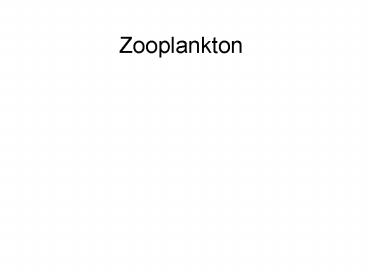Zooplankton PowerPoint PPT Presentation
1 / 13
Title: Zooplankton
1
Zooplankton
2
Chaoborus, Chironomidae
- Complex life history (benthic, aquatic juvenile,
emergent adult) - Major predators on macrozooplankton but sporadic
abundance
Lake Victoria
3
Rotifera
- 100 planktonic taxa, most abundant zoop
- Name from rotating corona
- Rapid development bloom
- Parthenogenetic (faculative)
- Female Egg Female
- Egg fertilized by male
Male and Female
4
Rotifers
- Up to 200 µm in size
- Omnivorous, eat picoplankton and nanoplankton,
flagellates, ciliates to up 40 µm
5
Crustaceans
Cladocerans
Copepods
- Chitin carapace, 0.2- 3 mm
- Tactile antennae
- Bisexual, 11-molt development, diapause
- Adjustable pigments
- Chitin carapace
- Antennae for movement, eyes
- Parthenogenetic, slower development than Rotifers
- Transparent
- Resting stage, ephippia
1 mm
6
Crustaceans
Copepods
Cladocerans
- Hop/sink swimmers
- Selective filter feeders (size, taste)
- Hungry
- Linked to clear-water phase
- Efficient swimmers
- Predators and detritovores
- Abundant in oligotrophic, dystrophic lakes
7
Seasonal Abundance
Algae
Zooplankton
- Grazing dynamics,
- efficiency
- Temperature
- Reproduction cycles
- Predation
Fish
8
Brooks and Dodson, 1965
Crystal Lake, CT 1942 average zoop size 0.8
mm Daphnia, Copepods No Alewife 1964 Average
zoop size 0.3 mm Huge rotifer bloom, small
Daphnia, copepods Zooplanktivorous Alewife
9
Experiment Manipulations
- Hrbacek, 1961
- 1957 Poltruba fish poisoned by toxic bloom,
restocked with - largemouth bass
10
- Piscivores vs. Zooplanktivorous fish
Zooplanktivores Zooplankton
Hrbacek, 1957 Trophic Cascade
11
Zooplankton and Nutrients
Algae
- Top-down phytoplankton control, bottom-up
stimulation - Stabilizing feedback
Zooplankton
Bacteria
12
Zooplankton and Nutrient Cycling
Elser et al., 2000 Grazer Stoichiometry
- Herbivores lower C (N,P) than food
- Lower NP than food
- Herbivores release N
- N supplement affects algae
- Decrease CP of food (negative feedback)
13
Conclusions
- Rotifers, Cladocerans, and Copepods are the most
common zooplankton in lakes - Zooplankton abundance is controlled by
interactions between food abundance, fish
predation, and zoop reproductive cycle - Changes in fish abundance and predation can have
major effect on zoop populations, and thereby
phytoplankton populations - Zooplankton grazing exerts major control on lake
metabolism, nutrient cycling

